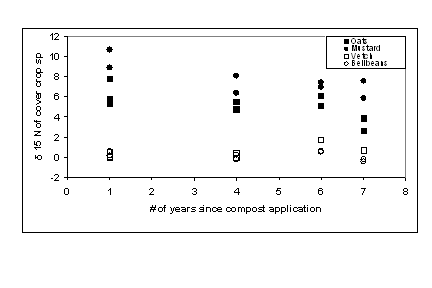
Saturday, 15 July 2006
150-21
Incorporating N Fixation Uncertainty into Nitrogen Budgets for Organic Vegetable Farms.
Katie Monsen and Carol Shennan. Univ of California Santa Cruz, ENVS / ISB 413, 1156 High St., Santa Cruz, CA 95064
Organic growers face the challenge of timing the availability of N from slowly mineralizing sources to match the nutritional needs of crop plants. Insufficient available soil N limits plant growth while excess mineral N during rainy periods or at dormant production stages is susceptible to loss to the environment. N lost by leaching during these periods wastes the time, energy and resources the grower invests in applying N sources and contributes to non-point source water pollution, a major problem that has been closely linked with agricultural activity, including on California's Central Coast. Winter legume cover crops play an important role in fertility management in organic vegetable systems in this region. Legumes such as bell beans (Vicia faba) and woollypod vetch (Vicia dasycarpa) planted in a mix with cereals cover the soil during the rainy season and add significant quantities of N through fixation. Because legume cover crop N fixation is key to fertility management in organic systems, it is a necessary component of nutrient budgets. Significant over- or underestimates of fixation make N inputs appear inaccurately high or low, which can make systems incorrectly appear to have an N excess, deficit or balance. We have used the δ15N natural abundance method to estimate the percent of N derived from the atmosphere (%Ndfa) at organic vegetable farms on California's Central Coast. In 2003-04, we planted vetch, bell beans and two reference species (oats, Avena sativa, and mustard, Brassica japonica) in replicated 2.8 x 7.6 m single-species plots in five sites with a range of 1-7 yrs since last compost application. All sites were on the same organic farm to minimize soil type and climatic differences. End-of-season aboveground biomass was analyzed for δ15N. The δ15N of the reference species was negatively correlated with the number of years since compost application but there was no relationship between δ15N of the legumes and compost history (Fig. 1). Additionally, there was no clear relationship between δ15N of the legumes and integrated seasonal soil fertility using reference species biomass as a proxy. This indicates that the reference and legume species were accessing different pools of soil N, with the reference species taking up more available N from the compost than the legumes. In addition, the estimates of %Ndfa by this method varied substantially by field within a single farm. Vetch fixation estimates ranged from 70 to 98% Ndfa with oats as the reference, or 75 to 99% Ndfa with mustard as the reference. Bell bean estimates ranged from 77 to 108% Ndfa with oats as the reference, or 79 to 105% Ndfa with mustard as the reference. While these data raise questions about how to best use the natural abundance method for estimating fixation in this system and whether a method that gives estimates over 100% is appropriate, the data also present a practical problem: how to develop N budgets for use by growers when fixation estimates vary by 25 to 30% for a single site. We will present our N budget for organic vegetable production on the Central Coast and demonstrate the effects of low, moderate and high fixation values on estimated N loss. We will also show how these estimated N losses compare within known losses due to leaching during winter rains.

Back to 3.1B Translating Soil Science into Agricultural & Environmental Policy - Poster
Back to WCSS
Back to The 18th World Congress of Soil Science (July 9-15, 2006)